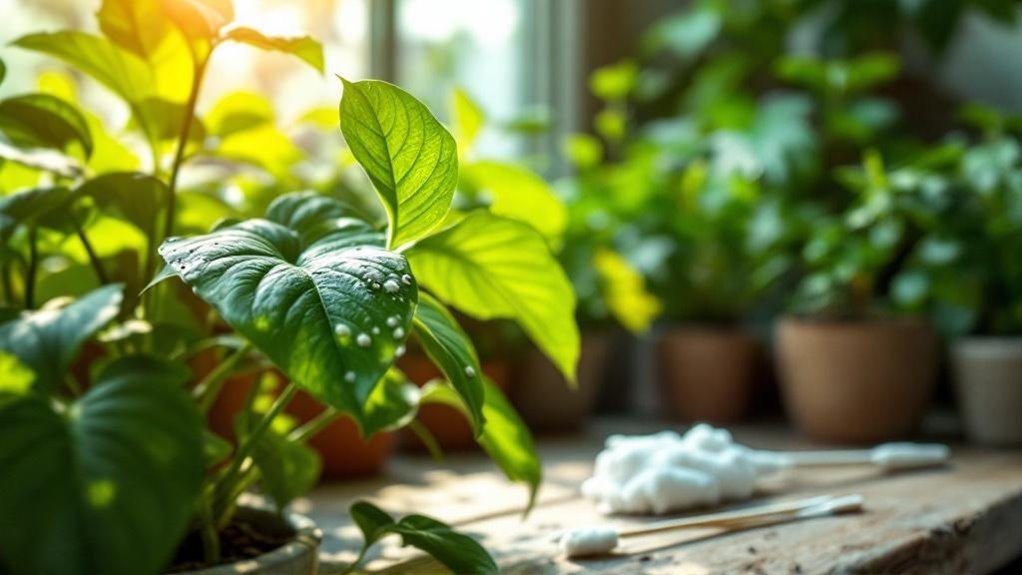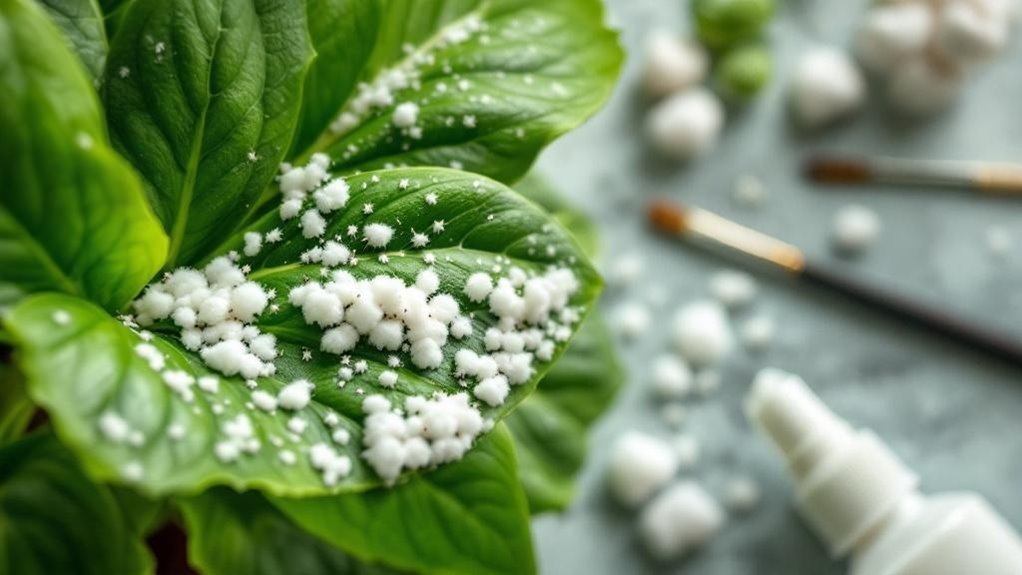If you’ve noticed tiny, cotton-like clusters on your indoor plants, you’re likely dealing with mealybugs—pests that can quickly sap your plant’s health if left unchecked. Treating them requires more than just a quick wipe-down; you’ll need a careful approach to fully eliminate these stubborn insects. Before you jump in, understanding their habits and how to tackle them effectively can save you time and frustration.
Signs and Symptoms of Mealybugs on Indoor Plants
You’ll often spot mealybugs by their distinctive cottony white wax coating, which looks like powdery deposits on your plant’s leaves and stems.
These pests mostly hide on the undersides of leaves and stems, so regular monitoring during watering helps with early detection.
Mealybugs often hide under leaves and stems, so check plants carefully when you water.
Signs of mealybugs include yellowing leaves, stunted growth, and dieback in your indoor plants.
Another clue is the sticky honeydew excretion they leave behind, which attracts ants and promotes sooty mold growth on infested plants.
If you notice sooty mold or a sticky residue, check your plants closely for mealybugs.
Catching these signs early can save your plants from serious damage and death, so stay vigilant with regular inspections to keep your indoor plants healthy and pest-free.
Identifying Mealybugs and Their Life Cycle
Although mealybugs are small, their impact on your indoor plants can be severe if you don’t identify them early. You’ll recognize mealybugs by their distinctive cottony, white waxy coating that covers their bodies. These pests often cluster on stems and leaves, signaling an infested plant.
Understanding their life cycles helps you control them effectively. Female mealybugs lay 100-200 eggs inside protective cottony sacs every 10-20 days. Eggs hatch into mobile nymphs called crawlers, which spread quickly before maturing into adults.
Because mealybugs reproduce rapidly, even a few can cause significant damage by sucking sap and weakening your plants. By identifying these tiny insects and knowing their life cycle stages, you can catch infestations early and protect your indoor plants from lasting harm.
Common Habitats and Why Mealybugs Are Difficult to Eliminate

Because mealybugs thrive in warm, moist environments, your indoor plants, especially those in greenhouses or poorly ventilated spaces, become their perfect breeding grounds.
These common habitats allow mealybugs to reproduce rapidly, leading to infestations that can quickly escalate. Their waxy coating makes them difficult to control, shielding them from many insecticides and enabling them to hide in crevices and plant debris.
Mealybugs reproduce quickly and their waxy coating protects them from insecticides, making infestations hard to control.
High reproduction rates mean a few mealybugs can lay hundreds of eggs every few weeks, complicating treatment efforts.
Additionally, mealybugs often coexist with other pests attracted by the honeydew they excrete, increasing stress on your plants and further hindering control measures.
Understanding these challenges helps you stay vigilant and persistent in your fight against mealybugs on indoor plants.
Damage Caused by Mealybugs
Mealybugs damage your indoor plants by sucking sap, which drains essential nutrients and causes leaves to yellow and growth to slow.
As they reproduce rapidly, infestations can quickly overwhelm your plants, leading to severe leaf drop and a decline in overall plant health.
Mealybugs excrete honeydew, a sticky substance that encourages the growth of sooty mold, further impairing photosynthesis and weakening your plants.
You might notice wilting, dieback, and poor vigor—clear signs that mealybug damage is affecting your plants.
Without timely intervention, these infestations can cause irreversible harm and even plant death.
Preparing for Mealybug Treatment

Before you start treatment, isolate any infested plants to stop the pests from spreading to your healthy ones.
Place them in a separate, well-ventilated area indoors.
Next, inspect your plants carefully for mealybugs, focusing on leaf undersides, stems, and crevices to gauge the infestation level.
Then, prepare your treatment solution by mixing equal parts rubbing alcohol and water, adding a few drops of dish soap to boost its effectiveness against mealybugs.
Gather these fundamentals for effective treatment:
- Rubbing alcohol (65%-70%) and cotton swabs for targeted application
- Spray bottle for even solution distribution
- A ventilated space to apply treatment safely without harming plants
This preparation guarantees your mealybug treatment proceeds smoothly and safely.
Manual Removal Techniques Using Isopropyl Alcohol
Once you’ve prepared your plants and treatment solution, you can begin manually removing mealybugs using isopropyl alcohol.
Dip a cotton swab in the 65%-70% isopropyl alcohol and carefully apply it directly to visible pests on your plant. This manual removal technique is effective because the alcohol kills mealybugs on contact, turning them light brown.
Be certain to treat all affected areas, including stems and leaf undersides, but avoid letting the alcohol touch healthy leaves to prevent damage.
After applying, rinse the plant thoroughly to minimize any adverse effects.
Repeat this treatment every 10 days to 2 weeks, and regularly inspect your plant for new infestations.
Promptly treating any remaining mealybugs guarantees your plant recovers fully and stays healthy.
Using Insecticidal Soaps and Neem Oil for Control
Two effective and eco-friendly options for controlling mealybugs on your indoor plants are insecticidal soaps and neem oil.
Insecticidal soap suffocates mealybugs, especially their soft-bodied nymphs, when you spray soapy water with thorough coverage on all affected areas. To make a homemade insecticidal soap, mix 1 tablespoon of pure liquid soap per quart of water and reapply every few days for small infestations.
Neem oil disrupts mealybugs’ feeding and reproduction; dilute 2 tablespoons in a gallon of water with dish soap and spray in early morning or late afternoon to avoid leaf burn.
Both options:
- Are gentle on beneficial insects
- Require careful application to all plant surfaces
- Are ideal before considering systemic insecticides for severe infestations
Applying Systemic Insecticides for Severe Infestations
If you’re dealing with a severe mealybug infestation, systemic insecticides offer a powerful solution by being absorbed into your plant, providing long-lasting internal protection that contact sprays can’t match.
To apply, mix a product containing active ingredients like dinotefuran or imidacloprid with water, then drench the soil or spray the foliage, ensuring thorough coverage for maximum absorption.
Always test a small area first to check for phytotoxicity. Avoid using systemic insecticides near flowering plants to protect pollinators.
After application, monitor the plant closely, as multiple treatments might be necessary to fully control the infestation and prevent re-infestation.
Using systemic insecticides wisely helps you regain control over severe mealybug infestations while minimizing harm to your indoor garden.
Post-Treatment Monitoring and Preventative Care
Because mealybugs can quickly return after treatment, you’ll want to inspect your plants every few days, focusing on leaf undersides and stems where these pests hide.
Effective post-treatment monitoring helps catch any early mealybug activity before infestations spread. During this phase, prune away dead or heavily infested foliage to promote healthy plants and better air circulation.
Maintain isolation for 4 to 6 weeks, ensuring no new signs of infestation appear before reintroducing your plants.
For ongoing preventative care, consider these steps:
- Regularly inspect plants to detect early signs of mealybugs
- Apply systemic insecticides or neem oil during peak growth for protection
- Keep plants healthy with proper watering and well-draining soil
Consistent monitoring and care will keep your indoor garden pest-free and thriving.
Frequently Asked Questions
How to Treat Mealybugs on Indoor Plants?
You should isolate infested plants, then use rubbing alcohol on visible mealybugs or spray a mix of alcohol, water, and soap. Repeat every 10–14 days, prune damaged parts, and monitor closely for re-infestation.
What Is the Best Control Method for Mealybugs?
You should isolate infested plants first, then apply isopropyl alcohol directly on mealybugs with a cotton swab. Spray a mix of alcohol, water, and soap regularly, and consider systemic insecticides for heavy infestations.
What Is the Best Mealybug Spray for Indoor Plants?
They say, “An ounce of prevention is worth a pound of cure.” You’ll want to use insecticidal soap or neem oil sprays—they’re effective, gentle on plants, and keep mealybugs at bay without harming beneficial insects in your indoor garden.
What Is the Best Medicine for Mealybugs?
You’ll want to use isopropyl alcohol diluted with water and dish soap for quick kills. For longer control, systemic insecticides like imidacloprid work well. Always test treatments on a small leaf first to avoid damage.
Final Thoughts
Now that you know how to spot and fight mealybugs, don’t let them take over your indoor garden. You’ve got the tools, the steps, and the know-how—but the real challenge? Staying vigilant. Those tiny pests can disappear only to return when you least expect it. So, keep a close eye, act fast, and never underestimate their persistence. Your plants depend on you—and with careful care, you’ll win this battle every time.
